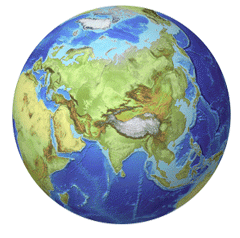 C O 2
C O 2  in the atmosphere.
in the atmosphere. C O 2
C O 2  in the atmosphere.
in the atmosphere.
Two intersecting loops of the carbon cycle.
A quite independent way that we know that fossil fuel burning and land clearing specifically are responsible for the increase in CO2 in the last 150 years is through the measurement of carbon isotopes.
Isotopes are simply different atoms with the same chemical behavior (isotope means “same type”) but with different masses. Carbon is composed of three different isotopes, 14C, 13C and 12C.
CO2 produced from burning fossil fuels or burning forests has quite a different isotopic composition from CO2 in the atmosphere.
Isotope geochemists have developed time series of variations in the 14C and 13C concentrations of atmospheric CO2. One of the methods used is to measure the 13C/12C in tree rings, and use this to infer those same ratios in atmospheric CO2. This works because during photosynthesis, trees take up carbon from the atmosphere and lay this carbon down as plant organic material in the form of rings, providing a snapshot of the atmospheric composition of that time.
If the ratio of 13C/12C in atmospheric CO2 goes up or down, so does the 13C/12C of the tree rings. This isn’t to say that the tree rings have the same isotopic composition as the atmosphere – as noted above, plants have a preference for the lighter isotopes, but as long as that preference doesn’t change much, the tree-ring changes wiil track the atmospheric changes.
Sequences of annual tree rings going back thousands of years have now been analyzed for their 13C/12C ratios.
Because the age of each ring is precisely known** we can make a graph of the atmospheric 13C/12C ratio vs. time. What is found is at no time in the last 10,000 years are the 13C/12C ratios in the atmosphere as low as they are today. Furthermore, the 13C/12C ratios begin to decline dramatically just as the CO2 starts to increase — around 1850 AD. This is exactly what we expect if the increased CO2 is in fact due to fossil fuel burning. Furthermore, we can trace the absorption of CO2 into the ocean by measuring the 13C/12C ratio of surface ocean waters. While the data are not as complete as the tree ring data (we have only been making these measurements for a few decades) we observe what is expected: the surface ocean 13C/12C is decreasing. Measurements of 13C/12C on corals and sponges — whose carbonate shells reflect the ocean chemistry just as tree rings record the atmospheric chemistry — show that this decline began about the same time as in the atmosphere; that is, when human CO2 production began to accelerate in earnest.***
In addition to the data from tree rings, there are also of measurements of the 13C/12C ratio in the CO2 trapped in ice cores. The tree ring and ice core data both show that the total change in the 13C/12C ratio of the atmosphere since 1850 is about 0.15%. This sounds very small but is actually very large relative to natural variability.
The results show that the full glacial-to-interglacial change in 13C/12C of the atmosphere — which took many thousand years — was about 0.03%, or about 5 times less than that observed in the last 150 years.
How do we know that recent CO2 increases are due to human activities?
Source: RealClimate, eric @ 22 December 2004.Stuiver, M., Burk, R. L. and Quay, P. D. 1984. 13C/12C ratios and the transfer of biospheric carbon to the atmosphere. J. Geophys. Res. 89, 11,731-11,748.
Francey, R.J., Allison, C.E., Etheridge, D.M., Trudinger, C.M., Enting, I.G., Leuenberger, M., Langenfelds, R.L., Michel, E., Steele, L.P., 1999. A 1000-year high precision record of d13Cin atmospheric CO2. Tellus 51B, 170–193.
Quay, P.D., B. Tilbrook, C.S. Wong. Oceanic uptake of fossil fuel CO2: carbon-13 evidence. Science 256 (1992), 74-79
—————————
Notes
*How much they can be expected to absorb in the long run is an interesting and important scientific question, discussed in some detail in Chapter 3 of the IPCC report.Clearly, though, it is our ability to produce CO2 faster than the ocean and biosphere can absorb that it is the fundamental cause of the observed increase since pre-industrial times.